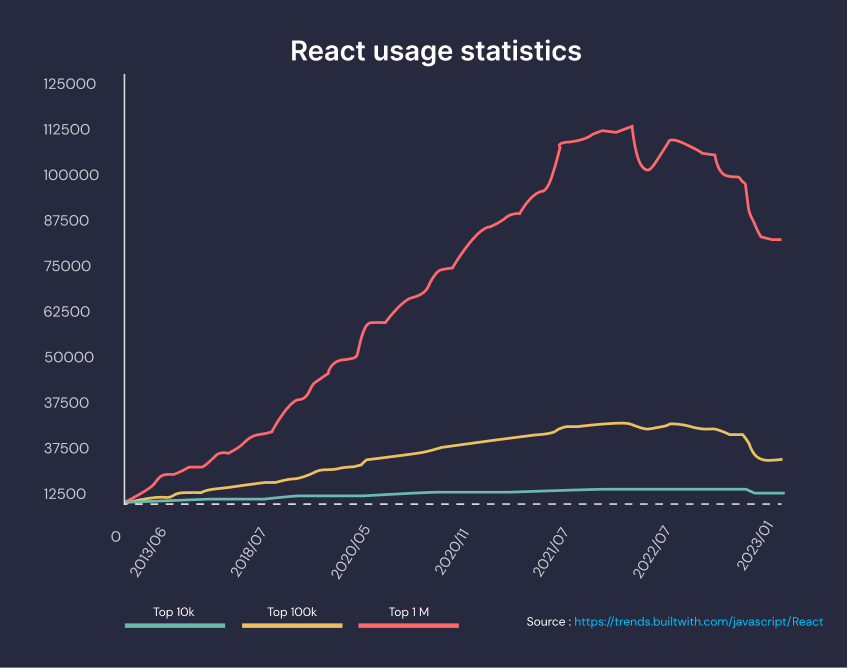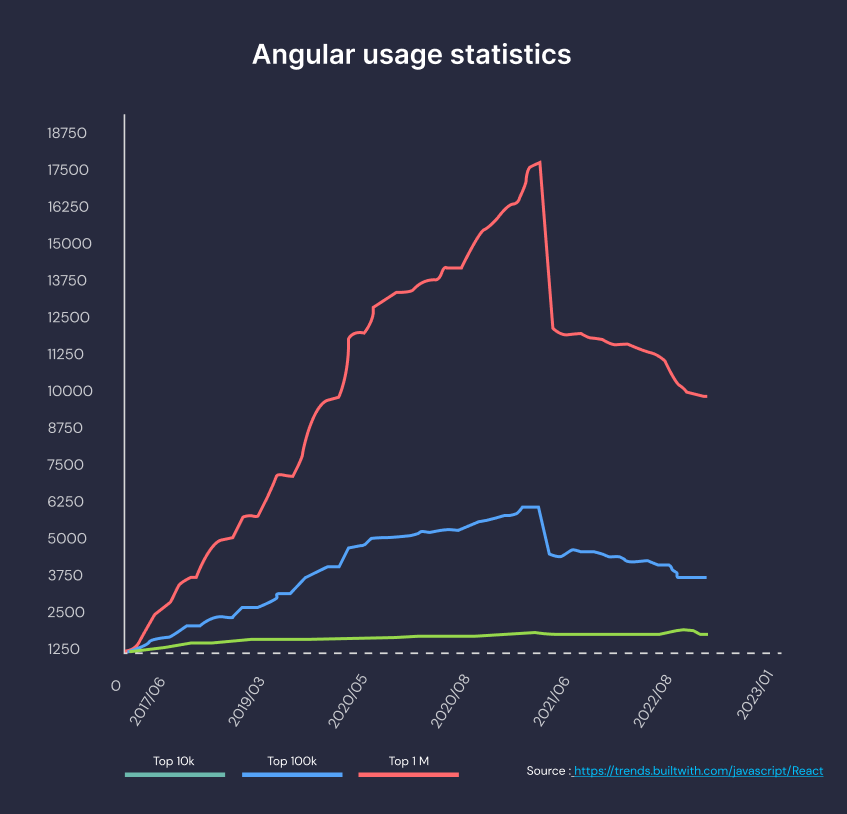In the dynamic world of front-end web development, selecting the right framework in the battle between Node vs React vs Angular, is akin to choosing the perfect tool for a complex job. It's pivotal. Among the multitude of front-end development tools, Node, Angular, and React emerge as heavyweight contenders, capturing the attention of front-end web app developers globally. But the lingering question remains: Which of these are the best web frontend frameworks?
This comprehensive guide aims to unravel the debate, dissecting their critical differences and offering expert insights.
What is React?
React is a JavaScript library that simplifies the creation of dynamic user interfaces by allowing developers to build reusable UI components and leveraging efficient rendering techniques. Imagine React as a versatile toolbox for web developers, offering a fresh approach to creating captivating user interfaces (UIs). It's like having a set of building blocks that you can reuse to construct stunning web pages, which is what makes it one of the best web frontend frameworks. Developed using JavaScript, React is all about making web development simpler and more enjoyable.
Why Choose React?

Well, for starters, React is like a friend who always has your back, helping you build websites that are fast, responsive, and scalable. Along with coding, it's also about creating experiences that leave a lasting impression on users. Plus, with React, you don't have to learn a whole new language. You can stick to good old JavaScript and still work wonders!
Advantages of React JS
React is a game-changer. Let's see why:
- Code That's Easy to Reuse and Predict: Think of React like building blocks. You can create pieces of code that you can use over and over again. This not only makes your codebase more organized but also makes it easier to predict how it will behave.
- Simplified Debugging with Clear Views: Debugging can be a headache but React makes it feel like a breeze. Its clear and simple views mean you spend less time scratching your head over what went wrong and more time fixing it.
- Speedy Development Time: Time is money, and React knows that. With its component-based approach, you can build things faster. That means you can bring your ideas to life and get them out into the world quicker. Also, a user-friendly syntax and vast array of tools mean you spend less time wrestling with your code and more time making progress.
- Smooth Sailing Between Versions: Updating your app shouldn't feel like navigating a maze. React makes it simple to move between different versions, so you can keep your app up to date without breaking a sweat.
- Ready for Mobile Adventures with React Native: Want to take your app on the road? React's got you covered. With React Native, you can build apps that work seamlessly on both iOS and Android, so you can reach more users with less effort.
- Quick Updates and Performance Boosts: Nobody likes waiting for a slow website to load. React understands that and makes sure your app runs like a well-oiled machine. With fast updates and top-notch performance, you'll keep your users coming back for more.
- A World of Possibilities with Third-Party Tools: Sometimes you need a little help from your friends. React plays nicely with tons of third-party libraries and tools, giving you the freedom to build your app your way.
Top Companies Using React JS
According to the 2023 State of Developer Ecosystem Survey, 57% of developers across the globe use React. Here are some top companies who’ve pioneered the React adoption.
- Netflix
- Airbnb
- Dropbox
What is Angular?
Angular, developed and maintained by Google's Angular team, stands as a prominent open-source JavaScript front-end framework. It reigns as the top choice for crafting scalable and high-performing mobile and web applications, employing a robust stack of HTML, CSS, and TypeScript. Angular's latest iteration, Angular 17, caters to enterprise-grade web application development, earning widespread adoption among leading companies.
This framework represents a complete overhaul from its predecessor, dating back to its inception in 2010. Angular adopts the Model View Controller (MVC) architecture, fragmenting tasks into manageable segments and enhancing initial webpage loading speed.

Angular boasts a comprehensive suite of features, including client-server communication and routing, all underpinned by TypeScript's robustness. The reason why it is considered among the web frontend frameworks is that it serves as a development platform equipped with integrated libraries, facilitating rapid front-end development from solo projects to enterprise-grade applications.
Distinguishing itself from React, Angular offers:
- Two-way data binding
- Dependency injection
- Virtual scrolling
- Angular CLI
- Built-in libraries
Advantages of Angular
- Structured and Modular Codebase: Angular's intuitive architecture promotes clean, modular code organization, facilitating easier maintenance and collaboration among teams.
- Efficient Development Lifecycle: With built-in tools like AngularCLI and robust testing utilities, Angular accelerates development, testing, and deployment processes, reducing time to market.
- Powerful Built-in Features: Angular comes bundled with powerful features such as RxJS for reactive programming, simplifying complex tasks and enhancing developer productivity.
- Seamless Integration and Support: Angular seamlessly integrates with HTTP, AJAX, and Observables, providing efficient handling of asynchronous operations and data fetching.
- Optimized Performance: Angular's server-side rendering capabilities and advanced optimization techniques ensure rapid rendering of views and improved overall application performance.
- Enhanced Developer Productivity: Extensive documentation, a strong community, and pre-built components empower developers to work more efficiently, focusing on innovation rather than boilerplate code.
- Superior User Experience: By optimizing rendering and enhancing interactivity, Angular delivers fast-loading, responsive web applications that prioritize user satisfaction.
Leading Companies Leveraging Angular
Angular's robust framework and extensive feature set have made it a preferred choice for top-tier companies across various industries. Here are some notable companies enjoying the benefits of Angular:
- Microsoft
- PayPal
- Nike
- The Guardian
- General Motors
- Upwork
Spoilt for choice?
What is Node?
Node, developed by Ryan Dahl in 2009, is an open-source, cross-platform JavaScript runtime built on Chrome's V8 JavaScript engine. Unlike Angular and React, which focus on front-end development, Node is designed for server-side scripting, enabling developers to use JavaScript to write server-side code and create scalable, high-performance web applications.
Node uses an event-driven, non-blocking I/O model, which makes it lightweight and efficient, particularly for data-intensive real-time applications that run across distributed devices.
Advantages of Node
- High Performance: Node's non-blocking I/O operations allow it to handle multiple requests simultaneously, making it highly performant for real-time applications.
- Scalability: Its event-driven architecture is ideal for building scalable applications, from single-page applications to complex enterprise systems.
- Full-Stack JavaScript: With Node, developers can use JavaScript for both client-side and server-side development, leading to more consistent and efficient development processes.
- Large Ecosystem: Node boasts a vast ecosystem of packages and libraries through npm (Node Package Manager), allowing developers to leverage existing modules to accelerate development.
- Community Support: A large, active community provides extensive resources, tutorials, and support, facilitating continuous learning and problem-solving.
- Microservices Architecture: Node is well-suited for microservices, allowing the development of small, independent services that can be deployed and scaled individually.
- Cross-Platform Compatibility: Node applications can run on various platforms, including Windows, Linux, and macOS, ensuring flexibility in deployment.
Leading Companies Leveraging Node
Node's versatility and performance have made it a go-to choice for many leading companies across different sectors. Here are some notable companies using Node:
- Netflix
- Uber
- eBay
- Walmart
- Medium
- Trello
An In-depth Comparison: Angular vs. React vs. Node
Choosing from the best web development tools is both an art and a science, with project needs at the heart of the decision. Angular, React, and Node each offer unique strengths and advantages. Here's a closer look at how they compare:
Code Quality and Maintainability
Angular: Angular's modular approach simplifies maintenance and reduces complexity, saving developers time and effort. By providing extensions for HTML, Angular promotes clean and maintainable JavaScript code, enhancing productivity and code readability.
React: React emphasizes component reusability and naming conventions, streamlining development and fostering collaboration. Developers can focus on writing efficient code without sacrificing readability.
Node: Node promotes a modular structure through its use of modules and npm packages, making code easier to manage and maintain. Its event-driven architecture aids in creating clean, organized code.
Testing: Ensuring Reliability
Angular: Offers a robust testing environment with built-in support for unit testing, end-to-end testing, and integration testing. Tools like Karma and Protractor enable thorough verification of application reliability.
React: Provides a flexible testing ecosystem, allowing developers to choose from various testing libraries and frameworks like Jest and Enzyme for unit and integration testing.
Node: Facilitates testing through numerous frameworks such as Mocha, Chai, and Jasmine, ensuring comprehensive test coverage for server-side code.
Data Binding: The Invisible Strings
Angular: Boasts seamless two-way data binding, ensuring automatic synchronization between interface elements and the model state. This bidirectional approach simplifies development and enhances interactivity.
React: Opts for one-way data binding, prioritizing control and predictability, empowering developers with greater control over application behavior.
Node: As a backend framework, it doesn't handle data binding directly but interacts with front-end frameworks for data management.

Component Structures: The Building Blocks
Angular: Embraces a structured MVC architecture, providing developers with a reliable and predictable development environment.
React: Takes a flexible approach, allowing developers to structure components based on specific project requirements.
Node: Utilizes a modular approach, promoting code reuse and organization, crucial for building scalable backend services.
DOM and Performance: The Heartbeat
Angular: Relies on the real DOM, ensuring precise and direct updates to the user interface, which can lead to performance bottlenecks in applications with frequent UI updates.
React: Employs a virtual DOM, optimizing performance by minimizing direct interactions with the actual DOM.
Node: Excels in handling I/O operations efficiently, making it ideal for real-time applications and data-intensive tasks.
Tools and Directives: The Enhancement Kits
Angular: Offers a comprehensive suite of built-in tools and directives, providing developers with a holistic solution for web development.
React: Adopts a lightweight approach, relying on external libraries like Redux for state management and React Router for routing.
Node: Leverages a vast array of npm packages to extend functionality, allowing developers to tailor their development environment.
Need more help?
Making the Choice
Choose React When You Need:
- Dynamic User Interfaces: Ideal for creating dynamic and interactive user interfaces with its component-based architecture and virtual DOM.
- Frequent UI Updates: Efficiently handles frequent UI updates, suitable for applications with dynamic content or real-time data.
- Mobile Application Development: React Native allows leveraging React skills for building native mobile apps.
- Flexibility and Scalability: Lightweight nature and modular architecture provide flexibility and scalability.
- Large Developer Community: Vast community support and extensive documentation.
Choose Angular When You Need:
- Enterprise-grade Applications: Comprehensive suite of features, including two-way data binding and dependency injection, for building large-scale applications.
- Type Safety and Code Quality: Strict type safety and robust code quality ensured by TypeScript.
- Built-in Tools and Directives: All-inclusive approach simplifies development for complex applications.
- Structured Architecture: Opinionated MVC architecture provides a clear and structured development environment.
- Comprehensive Testing Support: Built-in support for unit, end-to-end, and integration testing ensures application reliability.
Choose Node When You Need:
- High Performance: Handles multiple requests simultaneously with non-blocking I/O operations, ideal for real-time applications.
- Scalability: Event-driven architecture suitable for scalable applications.
- Full-Stack JavaScript: Enables consistent development processes with JavaScript for both client-side and server-side.
- Large Ecosystem: Vast ecosystem of packages and libraries through npm.
- Microservices Architecture: Well-suited for developing microservices that can be deployed and scaled individually.
- Cross-Platform Compatibility: Ensures flexibility in deployment across various platforms.
Final Thoughts
In the battle of Node vs React vs Angular, there's no one-size-fits-all solution. The choice ultimately depends on the specific requirements of your project, the preferences of your development team, and the long-term goals of your application. Angular excels in providing a comprehensive framework with built-in tools and robust architecture, making it suitable for enterprise-grade applications requiring strict code quality and scalability. React offers flexibility, a vibrant ecosystem, and a component-based approach, ideal for projects focusing on dynamic user interfaces, rapid development, and cross-platform compatibility. Node shines in backend development with its high performance, scalability, and full-stack JavaScript capabilities.
Whether you choose Angular, React, or Node, embracing expert guidance can help navigate the complexities of modern web development and ensure the success of your project.
We at Nalashaa are a team of experts who have helped multiple organizations with custom as well as packaged solutions, not just with web frontend frameworks, but with software engineering services in its entirety. Reach out to us today by writing to info@nalashaa.com, and we’ll help you make the choice!

